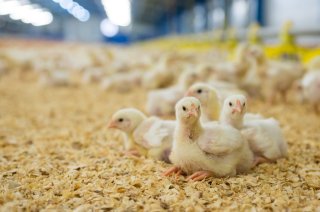
category_news
More diverse caecal microbiota decreases colonisation by ESBL E. coli
Broiler chickens may be protected at early ages from colonisation by ESBL-producing E. coli through a diverse microbiota. This is concluded based on a recent study on the development of ESBLs in the caecal microbiota of broilers in Dutch commercial flocks. It is the first study following the microbiota development and ESBL-colonisation during a full production round on a commercial farm.
Broilers are among the most common and dense livestock production systems, where in the past antimicrobials have been used extensively to promote animal health and performance. The continuous usage of antimicrobials has contributed to the appearance of resistant bacteria, such as extended-spectrum β-lactamase-producing Escherichia coli (ESBL-Ec). Exploring the dynamics of caecal microbiota of broilers can reveal windows of opportunity to implement intervention strategies that reduce the spread of resistant commensal or pathogenic bacteria.
Researchers of Wageningen University and Research studied the ESBL-Ec prevalence and successional dynamics of the caecal microbiota of developing broilers in a commercial flock during their production life cycle (0-35 days). For the study, broilers were divided into two groups: ESBL-Ec colonised or ESBL-Ec non-colonised. The broilers were not physically separated, they were kept in the same housing.
Both groups were compared looking at the richness, evenness and composition of the caecal microbiota. Furthermore, the role of age and ESBL-Ec status on the broilers’ caecal microbiota was studied.
Observations
“Already from day two into the research, we observed an increasing number of ESBL-Ec colonised broilers. The development followed a linear trend throughout the broilers’ production life cycle”, says Mike Brouwer of Wageningen Bioveterinary Research, one of the researchers involved in the project.
Over time, the caecal microbiota richness was consistently higher in ESBL-Ec non-colonised broilers. “Significant differences between both broilers’ groups, however, were found exclusively on day three.” An explanatory mathematical research model showed no explanatory power of the ESBL-Ec status. “The model did show that age explained 14 percent of the compositional variation of the caecal microbiota. We found that the microbial richness increased most from day 0 to day 21.”
Bacterial composition
Based on this study on the role of ESBL-Ec in the successional dynamics of the caecal microbiota in developing broilers, the researchers conclude that the presence of ESBL-Ec does not have consistent effects on the caecal microbiota of developing broilers. “All broilers tested negative on day 0 and 1 and thereafter its prevalence increased rapidly over time. Based on our findings we conclude that the farm environment is the most likely source for ESBLs”, according to Brouwer. “This study therefore highlights the importance of taking the natural dynamics of the host-microbiota development and colonisation of resistant bacteria into consideration.”
Over time the relative abundance of E. coli in de caecal microbiota decreased in both animal groups. “As broilers age, the microbial diversity increases, causing shifts in bacterial composition and abundances.” Despite the decline of E.coli (<5% relative abundance) the prevalence of ESBL-Ec was high at day 35. A possible explanation for this according to the research team could be that the other members of the microbial community might acquire, carry and contribute tot the spread of ESBL genes.